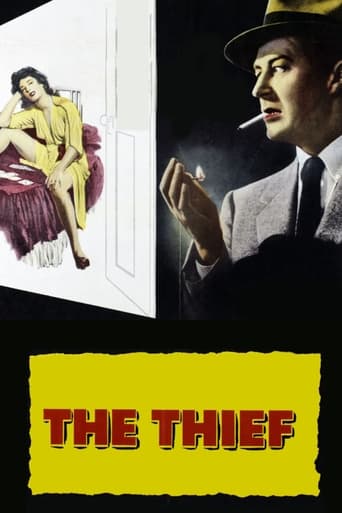jovana-13676
Since we are now in Cold War II, this movie deserves to be revisited. Ten minutes into the film with no dialog, and then twenty, and the music just keeps your stomach turning to the very end with no spoken word. I'll give it a star and a half just for this bold silent experimentation in the talkies era. This film predates European art films that would emerge a decade later and emulates the great Russian experimental films of the silent era with its splendid photography and acting. I'd give Ray Milland another Oscar for this. By the end of the movie he does look ten years older.
bkoganbing
This rather curious and open ended film was something that no major studio back then would have taken a chance on. It fell to Ray Milland and independent producer Harry Popkin to get this project finished and released by United Artists.Without dialog other elements in the film have to carry the story along and two of them are there. The facial expressions of Ray Milland who is on screen for about 90% of the film are marvelous. The second is the Oscar nominated score from Herschel Burke Gilbert. But the third for silent films are those all important titles inserted where needed so you followed the story where the writer and director wanted to go.Those titles might have explained Milland's motivations for what he was doing as a scientist who is doubling as a spy. Whatever they were the anguish on Milland's face told you this was not something he was doing willingly. As The Thief was made in 1952 at the height of the Cold War there were certain parameters in how the story had to end and they were followed.Some things need no dialog however. Rita Gam made her film debut as a slinky and sexy woman in the next apartment. Those looks she gives to Milland and that sexy body language need no words.The Thief is an interesting and somewhat entertaining film from Milland which while it doesn't succeed totally is still something to be checked out.
Martin Teller
One of the fun things about noir is few of its defining characteristics are prerequisites. There are perfectly good noirs without a femme fatale, or without chiaroscuro lighting, or outside of an urban setting. And not all noirs have the trademark snappy dialogue... the crisp lines, distinctive lingo, backbiting remarks. So why not a noir with NO dialogue? Not a word is uttered in this look at a nuclear physicist selling secrets to an unknown enemy. We see him (Ray Millard, in a bravura performance) smuggling out photos, we see the convoluted machinations of the spy ring, the procedures of the authorities trying to catch him, and we see him wrestle with fear, doubt, conscience. When dealing with a gimmick film, several questions come up. Is the gimmick pulled off well? For the most part, yes. There is one "cheat" where we see a teletype of police communication, but other than that it stays true to the conceit without seeming forced. There isn't a moment where you think "This scene really needs some dialogue." Is the gimmick distracting? Yes and no. I was always aware of it in the back of the mind, but it wasn't annoying me or anything. Would the film be better without the gimmick? I don't think so. Again, there wasn't a scene where I felt dialogue was essential. We're spared the gung-ho narration of a docudrama like House on 92nd Street, and there's a refreshing ambiguity in that we have no idea (nor do we really care) who this enemy is, or how Milland got involved with them. These unanswered questions are rare in noir, or in any movie of the period. And putting aside the lack of dialogue, it's a nice, tight thriller with a mighty fine chase scene, psychological tension, great location work, and a very good score (which becomes especially important in this case).
mackjay2
Don't' be put off by the 'gimmick' of a dialog-free movie. THE THIEF is an engrossing, extremely well-made movie. Right off the bat we can expect quality with Ray Milland in the lead: the man could act. And THE THIEF is a graphic demonstration of how acting requires much, much more than good line-reading. Milland immerses himself in the drama from the word go, and we almost never think of him as an actor until the end, when the impact of the film really hits. This is a powerful performance, in the league of some of the best from the silent era (only more realistic in style). Russell Rouse presents us with a story that bristles with suspense in some scenes. First time around, it may be a slight challenge to know what's going on, but it's soon clear that exact details are not important. We only need to know that Milland plays a Washington D.C. scientist who is microfilming top-secret government documents and passing them on to agents who remain obscure. His main contact is played very nicely by Martin Gabel, an actor with a face perfect for sinister, wordless intrigue.Just as important as the acting and directing is the music score. Hershel Burke Gilbert must have outdone himself for this project. This is an excellent score. Never obtrusive, always supportive of the action; pleasing, but never calling attention to itself. The music really makes the film work. An example of how intelligent the approach to the scoring is comes at the film's climax when Milland is followed to the very top of the Empire State Building, the music stops completely for about ten minutes. The effect is downright Hitchcockian -- an extremely effective sequence.Also worthy of mention is the persistent use of locations: D.C and New York in 1952 are almost characters unto themselves. This is another superb film that document the bygone look of some great urban locations. Very highly recommended.


 AD
AD
